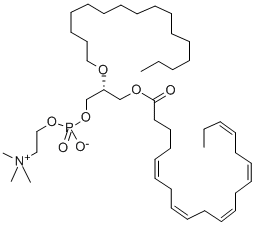EPA
- CAS NO.:10417-94-4
- Empirical Formula: C20H30O2
- Molecular Weight: 302.45
- MDL number: MFCD00065716
- SAFETY DATA SHEET (SDS)
- Update Date: 2025-12-25 11:31:46

What is EPA?
Description
EPA is an ω-
Chemical properties
Colorless Oil
The Uses of EPA
cis-5,8,11,14,17-Eicosapentaenoic acid has been used:
- to test pharmacologic effect on steatosis in hepatocytes
- as an analytical standard in Raman spectra measurements to characterize human breast cancer samples
- in lipid peroxidation assay in mouse embryonic fibroblasts and in pre-treatment of cells for cell viability studies
The Uses of EPA
Important polyunsaturated fatty acid of the marine food chain that serves as a precursor for the prostaglandin-3 and thromboxane-3 families. It differs from arachidonic acid (the eicosatetraenoic acid that is a precursor for the prostaglandin and thromboxane-2 families) by the extra double bond between the third and fourth carbons from the “methyl end” of the molecule. Antilipemic.
The Uses of EPA
cis-5,8,11,14,17-Eicosapentaenoic acid has been used an analytical standard for the synthesis followed by investigation of pharmacological properties of aconitine-derived lipo-alkaloids.
Indications
EPA can be used for lowering elevated triglycerides in those who are hyperglyceridemic. In addition, EPA may play a therapeutic role in patients with cystic fibrosis by reducing disease severity and may play a similar role in type 2 diabetics in slowing the progression of diabetic nephropathy.
Background
Important polyunsaturated fatty acid found in fish oils. It serves as the precursor for the prostaglandin-3 and thromboxane-3 families. A diet rich in eicosapentaenoic acid lowers serum lipid concentration, reduces incidence of cardiovascular disorders, prevents platelet aggregation, and inhibits arachidonic acid conversion into the thromboxane-2 and prostaglandin-2 families.
What are the applications of Application
Eicosa-5Z,8Z,11Z,14Z,17Z-pentaenoic Acid (20:5, n-3) is a 5-LO inhibitor
Definition
ChEBI: An icosapentaenoic acid having five cis-double bonds at positions 5, 8, 11, 14 and 17.
brand name
Decabid (Lilly).
General Description
Eicosapentaenoic acid (cis-5,8,11,14,17), also known as EPA, is a long-chain omega-3 fatty acid. Studies suggests that EPA as well as other fatty acids can serve as biomarkers for cardiovascular disease, and nutritional and metabolic disorders. This certified solution standard is suitable for use as starting material in the preparation of linearity standards, calibrators, or controls in mass spectrometry-based EPA testing applications such as assessment of cardiovascular?disease risk and fatty acid deficiency, and detection and quantification of EPA in nutraceuticals and dietary supplements.
Biochem/physiol Actions
5-Lipoxygenase inhibitor; reduces thromboxane A2 production.
Pharmacokinetics
Eicosanoids are chemical messengers derived from 20-carbon polyunsaturated fatty acids that play critical roles in immune and inflammatory responses. Both 20-carbon omega-6 fatty acids (arachidonic acid) and 20-carbon omega-3 fatty acids (EPA) can be found in cell membranes. During an inflammatory response, arachidonic acid and EPA are metabolized by enzymes known as cyclooxygenases and lipoxygenases to form eicosanoids. Increasing omega-3 fatty acid intake increases the EPA content of cell membranes and decreases the arachidonic acid content, resulting in higher proportions of eicosanoids derived from EPA. Physiologic responses to arachidonic acid-derived eicosanoids differ from responses to EPA-derived eicosanoids. In general, eicosanoids derived from EPA are less potent inducers of inflammation, blood vessel constriction, and clotting than eicosanoids derived from arachidonic acid.
Metabolism
Not Available
References
1) Lee et al. (1985), Effect of dietary enrichment with eicosapentaenoic and docosahexaenoic acids on in vitro neutrophil and monocyte leukotriene generation and neutrophil function; N. Engl. J. Med., 312 1217 2) Nicholson et al. (2013), The role of marine n-3 fatty acids in improving cardiovascular health: a review; Food Funct., 4 357
Properties of EPA
| Melting point: | −54-−53 °C(lit.) |
| Boiling point: | 439℃ |
| Density | 0.943 g/mL at 25 °C(lit.) |
| refractive index | n |
| Flash point: | 93 °C |
| storage temp. | -20°C |
| solubility | Soluble in methanol |
| form | liquid |
| pka | 4.75±0.10(Predicted) |
| color | Colorless to pale yellow |
| Sensitive | Air & Light Sensitive |
| Merck | 14,3531 |
| BRN | 1714433 |
| Stability: | Stable for 1 year as supplied (unopened). After opening, EPA must be stored under inert gas at -80°C. Solutions in DMSO or ethanol should also be stored under inert gas and may be kept at -80°C for up to 2 months. |
Safety information for EPA
| Signal word | Danger |
| Pictogram(s) |
 Flame Flammables GHS02  Exclamation Mark Irritant GHS07 |
| GHS Hazard Statements |
H225:Flammable liquids H319:Serious eye damage/eye irritation |
| Precautionary Statement Codes |
P210:Keep away from heat/sparks/open flames/hot surfaces. — No smoking. P305+P351+P338:IF IN EYES: Rinse cautiously with water for several minutes. Remove contact lenses, if present and easy to do. Continuerinsing. |
Computed Descriptors for EPA
| InChIKey | RRGOKSYVAZDNKR-ARJAWSKDSA-N |
New Products
Indole Methyl Resin tert-butyl 9-methoxy-3-azaspiro[5.5]undecane-3-carboxylate Boc-His(Boc)-OH 2-CTC Resin 4-Chloro-7-tosy1-7Hpyrrolo[2,3-d]pyrimidine 5,7-Dibromo-1H-indole 2,5-dichloro-N-hydroxy-4,6-dimethylpyridine-3-carboximidamide 2,2-Dimethoxy-7-azaspiro[3.5]nonane hydrochloride 4-chloromethyl-5-methyl-1,3-dioxol-2-one (DMDO-Cl) R-2-BENZYLOXY PROPIONIC ACID 1,1’-CARBONYLDIIMIDAZOLE 1,1’-CARBONYLDI (1,2-4 TRIAZOLE) N-METHYL INDAZOLE-3-CARBOXYLIC ACID 4-((2-hydroxyethyl)thio)benzoic acid 1-(TERT-BUTOXYCARBONYL)-2-PYRROLIDINONE Methyl 6-methylnicotinate 3-Pyridineacrylic acid tert-Butyl carbazate TETRAHYDRO-2H-PYRAN-3-OL 2-((4-morpholinophenylamino) (methylthio) methylene) malononitrile 3-(4-morpholinophenylamino)-5-amino-1H-pyrazole-4-carbonitrile 2,4-dihydroxybenzaldehyde 1,3-Diethyl-1,3-Diphenylurea Methyl 2-methylquinoline-6-carboxylateRelated products of tetrahydrofuran








You may like
-
 10417-94-4 99%View Details
10417-94-4 99%View Details
10417-94-4 -
 all cis-5,8,11,14,17-Eicosapentaenoic Acid CAS 10417-94-4View Details
all cis-5,8,11,14,17-Eicosapentaenoic Acid CAS 10417-94-4View Details
10417-94-4 -
 Thermo Scientific Chemicals cis-5,8,11,14,17-Eicosapentaenoic acid CAS 10417-94-4View Details
Thermo Scientific Chemicals cis-5,8,11,14,17-Eicosapentaenoic acid CAS 10417-94-4View Details
10417-94-4 -
 Eicosapentaenoic acid 95% CAS 10417-94-4View Details
Eicosapentaenoic acid 95% CAS 10417-94-4View Details
10417-94-4 -
 cis-5,8,11,14,17-Eicosapentaenoic acid CAS 10417-94-4View Details
cis-5,8,11,14,17-Eicosapentaenoic acid CAS 10417-94-4View Details
10417-94-4 -
 cis-5,8,11,14,17-Eicosapentaenoic acid CAS 10417-94-4View Details
cis-5,8,11,14,17-Eicosapentaenoic acid CAS 10417-94-4View Details
10417-94-4 -
 Pyridine 99.5% HPLC /UV SpectroscopyView Details
Pyridine 99.5% HPLC /UV SpectroscopyView Details
110-86-1 -
 Thiourea 99% ARView Details
Thiourea 99% ARView Details
62-56-6
